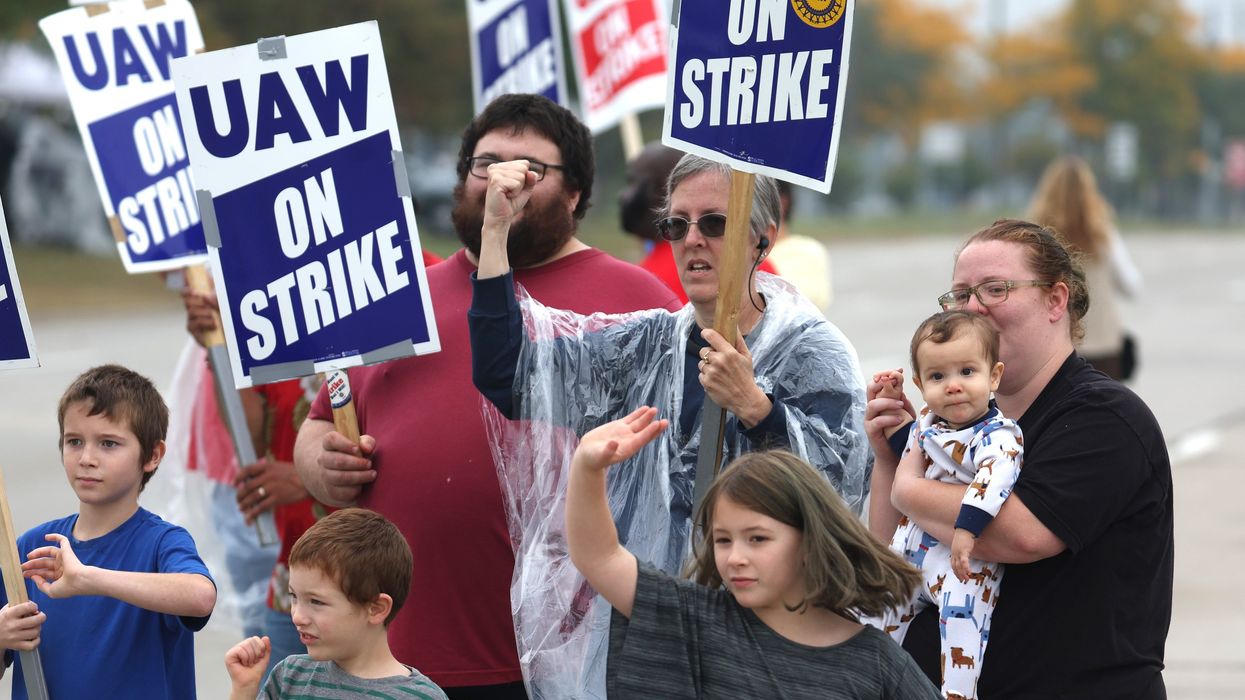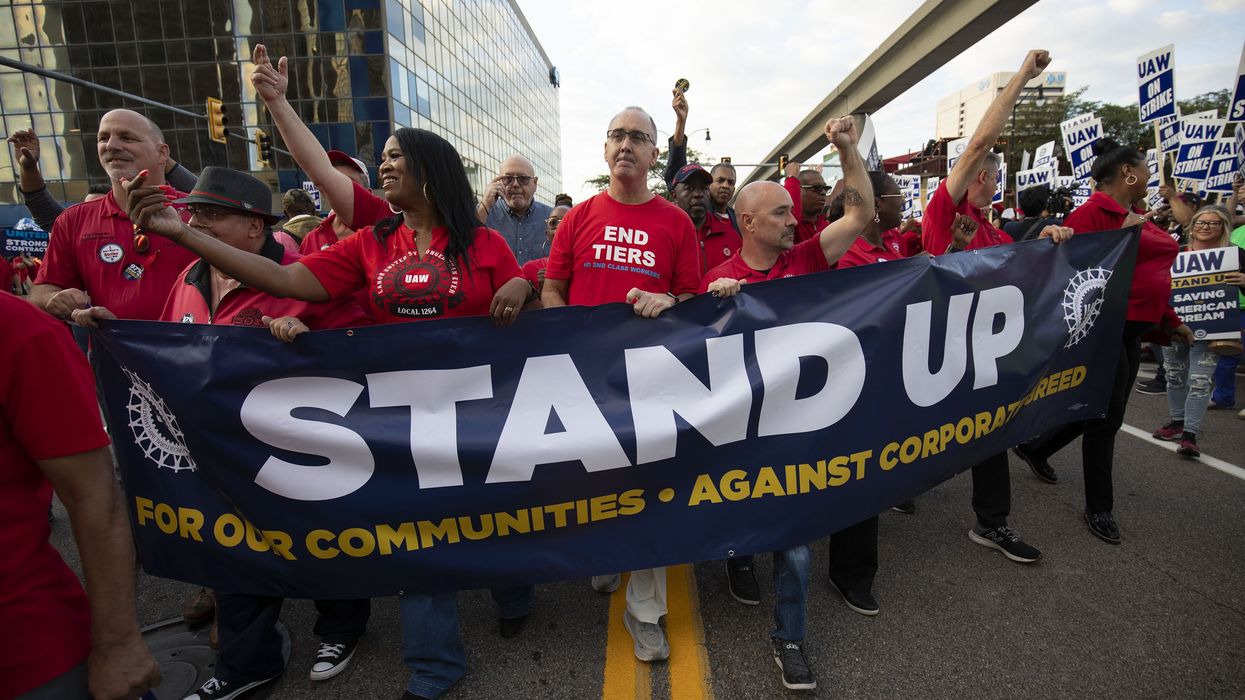UAW Strike Put Us on Better Road to Energy Transition
We now know that job growth and electric vehicles can go hand in hand.
When the United Auto Workers (UAW) started its strike against Ford, GM, and Stellantis earlier this year, a grim storyline took shape in the press: This strike pitted President Biden’s push for a transition to electric vehicles (EVs) against his support for workers.
Writing about the strike and the transition to zero-emitting vehicles, the New York Times put it this way: “The political challenge posed by the industry’s transition to electric cars may be only beginning.” Politico was one of any number of publications issuing a simple warning: “UAW Strike Could Disrupt EV Rollout.” Two so-called facts were seemingly inarguable: Electric vehicles require far fewer workers to build, and none of the new battery plants could be unionized.
But now that the strike is over—more quickly than many assumed and on much better terms for workers than analysts had said was possible—a different set of lessons are clear, and they are the exact opposite of what many in the media and hot take marketplace had predicted:
- The Big Three automakers can invest in both their workers and the factories to make new EVs.
- Workers at many of the new battery plants can enjoy the same union protection as other autoworkers or have an easier pathway to join the union.
- Building EVs can create more jobs over the next few decades as the industry builds up its capacity and know-how.
Before examining each of these three points, it’s important to correct one misunderstanding.
While many commentators tried to pit union workers against electric vehicles, neither the UAW nor environmental groups ever did so. Just the opposite. Back in March of 2021, the UAW issued a white paper that called for specific ways the new EV industry could benefit workers: “The growth of EVs must be an opportunity to reinvest in American manufacturing, with union workers making the vehicles of the future.”
Meanwhile, NRDC was one of more than 100 green groups that sent a letter to the CEOs of the Big Three and specifically endorsed the UAW’s bargaining position: “Only through meeting these demands will the United States ensure a just transition to a renewable energy future.”
With the UAW contract in hand, autoworkers can get long-overdue pay hikes while automakers continue to make the investments they need to make (and frankly, should have made years ago) in building electric vehicles.
As the UAW strike began in mid-September, the Big Three executives and outside commentators pitted the workers’ demands for fair wages against the need for new investments in battery plants and EV factories. Ford CEO Jim Farley went so far as to warn that the workers’ demands would force Ford to scrap its investments in electric vehicles, saying the UAW’s contract demands would force the company to “choose between going out of business and rewarding our workers,” according to CleanTechnica.
But the reality was much different. The auto companies have billions of dollars in profits to draw from for these new investments, and worker salaries are just a small slice of their costs.
The Big Three made $21 billion in profits so far this year and $250 billion over the past decade. All of the CEOs have been raking in millions of dollars in their salaries and incentives. Worker salaries, on the other hand, make up just 5 percent of the cost of final assembly of a new vehicle, a study cited by the New York Times concluded.
And now, with the UAW contract in hand, autoworkers can get long-overdue pay hikes while automakers continue to make the investments they need to make (and frankly, should have made years ago) in building electric vehicles.
A big part of these investments is in building new battery plants. The auto companies have set up joint ventures to build many of them, and the UAW made it a top priority during bargaining to ensure these new plants are captured under each automaker’s master agreement or that the workers at these plants have other pathways to unionization. At first, the automakers balked, and outside analysts said this would be a bridge too far.
The Associated Press reported: “Ford’s Farley accused the union of holding an agreement hostage over union representation of battery plant workers. On a conference call with industry analysts, he said high wages at battery plants would raise the price of Ford’s electric vehicles above those from Tesla and other competitors.”
But then the ground started to shift. In a dramatic, Friday evening announcement in the midst of the strike, UAW President Shawn Fain announced that GM had agreed to unionize its battery plants. “We have had a major breakthrough that has not only dramatically changed negotiations but is going to change the future of our union and the future of our industry,” Fain said.
Stellantis soon followed, and even Ford agreed to create strong pathways for workers at future battery plants to fast-track union representation. There will be hard work ahead to ensure that all of these plants get union representation, but the agreement goes a long way toward making it happen.
Last, while this wasn’t part of the strike itself, one thing we learned along the way is that job growth and electric vehicles can go hand in hand. For years, a shadowy estimate has circulated around this transition: EVs, it was said, require 30 percent fewer workers to make; the reason being that an EV has fewer moving parts and fewer parts means fewer workers.
Except that it’s just not accurate. A stunning story from Emily Pontecorvo at Heatmap concludes: “Whether or not the U.S. is able to build up domestic battery production, early evidence of the EV transition in the United States shows that EVs may require more labor, even in the final assembly stages.” If you include the battery production figures, this new industry could create thousands more good manufacturing jobs in this country. (Pontecorvo’s full article is worth taking the time to read. There is a lot to it.)
So, the results are in, and the conclusion is clear: With a union agreement in place that includes new measures to help unionize battery plants, the predicate is set to ensure that workers benefit while the United States transitions to electric vehicles. Yes, as we have seen recently, the road ahead isn’t flat and straight. There will be twists and turns, ups and downs. But the general direction is crystal clear. We are on the road to a better tomorrow.


